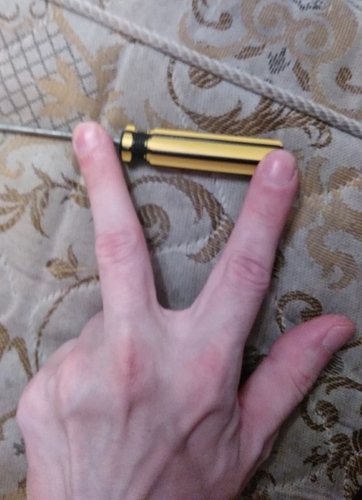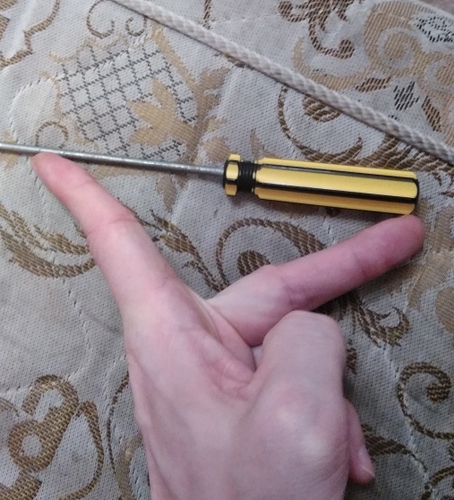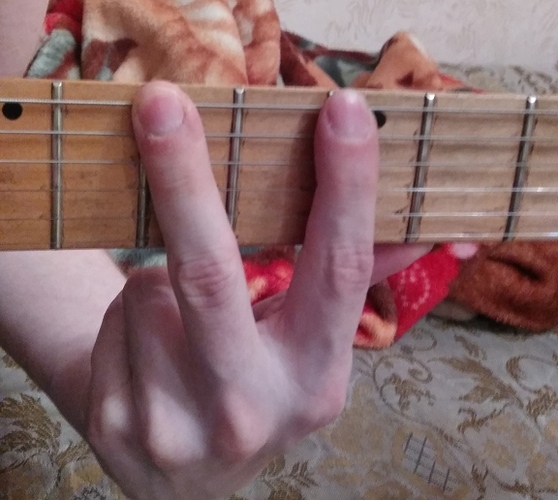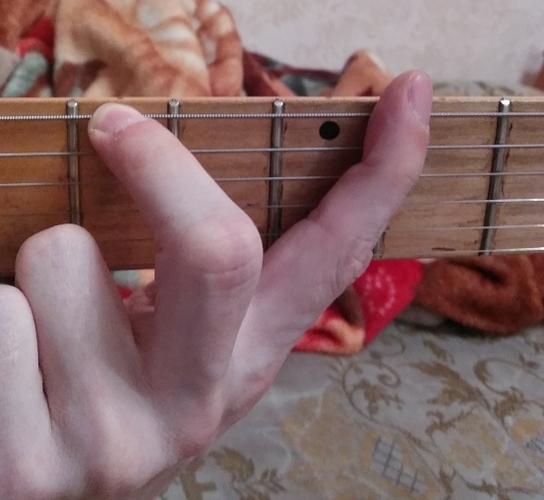Oh, gotcha. And here I was thinking you were like Rusty-Cooley-level flexible.  That makes MUCH more sense, and your point about the shifts makes a lot of sense too. Kind of what I was getting at with the Technical Difficulties run, as well.
That makes MUCH more sense, and your point about the shifts makes a lot of sense too. Kind of what I was getting at with the Technical Difficulties run, as well. 
This whole thread is extremely interesting and almost everything said works for me.
BUT
I have plenty of students who have much more interconnectedness between 2 and 3 than between 3 and 4, and they prefer to play 1-3-4 than 1-2-3.
They all have the same posture since they are all my students, but not the same hands obviously.
Sometimes beginner students just come up and have almost total independance between 3 and 4.
Actually I thought until now that there are two category of people : those who have difficulties to move 2 and 3 independently, and those who have difficulties to move 3 and 4 independently.
Hi @MartinHamiche.
I’m happy to be shown that I’m wrong on any point; it would mean I’ve learned something.
I’m not a teacher. I don’t have access to a large group of guitar players to survey. However, I’ve literally never met anybody who can maintain a trill between their 3rd and 4th fingers at their maximum speed for more than a few seconds.
Personally, I could probably trill (1 2), (1 3) or (1 4) for a long time without fatigue. I’m sure I could trill (2 4) for minutes, though maybe not as long as combinations with the 1st finger. However, I cannot maintain a (3 4) trill for more than a few seconds.
I’ve spent a lot of time developing finger independence. I can comfortably maintain (1 3 4) cycles at Paul Gilbert like speeds. I’ve have practiced every possible finger combination for hammers (ascending, descending and “from nowhere”) and pull-offs. I’ve played Holdsworth lines. I can even perform (1 3 4) cycles at a Shawn Lane like speed, though as I’ve said, it quickly leads to fatigue.
The level of independence of my 3rd and 4th fingers is good, by any standard. That said, the independence of my 3rd and 4th fingers is substantially lower than that of the other combinations. Perhaps my potential for independence between my 3rd and 4th fingers is simply lower than my potential for independence with other combinations. It certainly seems so.
Maybe some people have a greater potential for independence between 3 and 4 than I have. I would believe this.
Maybe some people have people have greater potential for independence between 3 and 4 than some other combinations of their fingers. I would believe these people are a very, very small minority.
Maybe some beginner students have naturally greater independence with (3 4) and others have naturally greater independence with (2 3). That seems reasonable. I’m not really concerned with what beginning students do or do not have difficulty with. I’m concerned with the upper limits of what is feasible for an advanced player, based on anatomical and physiological factors.
I’m not discounting your post, however. Not at all. Maybe you could answer some questions for me? I’d love a teacher’s input, all other teachers are of course welcome to answer also.
Have any of your students who prefer (3 4) combinations or (1 3 4) cycles spent significant time developing finger independence between their 2nd and 3rd fingers, and yet still maintained their original preference?
Can any of your students who prefer (3 4) combinations or (1 3 4) cycles maintain a (3 4) trill at their maximum speed for an extended period (say a minute, or even just more than a few seconds)?
Have any of your students who prefer (3 4) combinations or (1 3 4) cycles developed their fretting hand technique to a very high level? For example, including (but not limited to) competence with all combinations of fingers for ascending or descending hammers and pull-offs, or perhaps some Holdsworth or Garsed style legato lines?
Can any of your students who prefer (3 4) combinations or (1 3 4) cycles perform these combinations/cycles at extreme speeds for extended periods without fatigue?
This might seem like an absurdly high standard to demand, but this is the level of playing I’m interested in.
Apologizes, it seems that I have misunderstood the aim of this post. I thought the idea was to define principles who might be beneficial to a majority of guitar players just like CtC.
If the goal is rather to help the 0.5% to reach the 0.05% top level then I’m afraid my input is off topic 
No need to apologize at all.
That would be a lovely thing to discover, and I’d be delighted if anything I’ve shared has that kind of application. I’d hope that some of the insights would be helpful to everybody.
I’d imagine that the idea that lifting off to a lower note that’s already fretted being efficient, or the basic idea that fast playing is easier if the fretting hand fingers each have two notes’ duration between fretting should be helpful to everybody. I think those are universal principles that should help everybody.
Honestly though, that wasn’t my goal. Ultimately, I formalized this concept to answer a question I’ve had about guitar playing for several years. As mentioned, I can play some patterns/licks on Shawn Lane’s Power Licks/Power Solos at close to full speed. That speed in those patterns/licks never translated to greater speed in my playing as a whole. I wanted to understand why.
Your discussion of 3-4 VS 2-4 has been very helpful to me - for example it sort of answers my question below. In detail, your analysis supports my suspicion that my time is better spent working on alternative fretting arrangements, as opposed to obsessively practicing 3-4:
EDIT: note also how Shawn avoids the 3-4 hammer in the whole-half sequence, doing instead 2-4 (just after he says “even minor”):
His augmented stretch at 25:25 is honestly inhuman. How does he keep his hand so perfectly positioned.
Answered in video.
Chiming in here - while I definitely tend to be self-deprecating, if asked at gunpoint I would not describe myself as a beginner guitarist. I also definitely have greater independence between 3-4 than I do between 2-3.
It’s entirely possible there’s an element of nature vs nurture here, and I’ve spent a lot more time working on 3-4 than I have at 2-3. But, I suspect part of the reason for this is 3-4 immediately felt easier to me than 2-3.
So, with that in mind, IS it possible that there’s a fair amount of genetic variation here, and some players just legitimately have a natural inclination to better pinkie/ring finger independence than ring/middle?
EDIT - super interesting conversation, btw. 
Hi @Drew. I’m really very interested to hear how much your comfort with (2 3) improves as you work on it, if you’re still planning on putting time into developing that combination.
I fully believe that some beginners might initially prefer (3 4) to (2 3), and it’s totally natural that they would then gravitate toward certain fingerings based on that preference.
I hope @MartinHamiche didn’t find me dismissive of his input or condescending in some way, that definitely wasn’t my intention. I’m just not comfortable accepting the initial preferences of those beginning students as evidence that they have greater potential independence with (3 4) than (2 3). Beginners can have all sorts of unusual preferences, many of which change as they develop.
Maybe. I don’t now and I don’t want to claim that I have certain knowledge. Maybe they’re out there, maybe you’re one of them. I am certain that I am not one of them.
No worries Tom, I understand your opinion which totally makes sense!
I’m actually just thinking about thinking about everything said in the thread and trying to find counter-examples, but I admit I didn’t find any until now 
Hey Tom - my practice time is definitely somewhat constrained these days between work, the cycling season, and a girlfriend who actually expects me to spend time with her, so most of my playing these days is for the joy of it… But even then simply being aware of something can help you work on it so while I’m not sitting down and doing a ton of structured drilling I’m also definitely working on incorporating more 2-3 movement into my improv playing. Time will tell there.
That said - if there IS a difference between different players in faculty with 2-3 vs 3-4 stretches, then it ought to come out somehow in human biology, no? kind of like your original point on the finger independence, you ought to see some anatomical differences. If you don’t, then my greater 3-4 comfort than 2-3 is purely a product of experience and not biology, and that gap will lessen over time.
I found that sometimes it’s easier to use 2-3, sometimes 3-4. It depends on material. Fo rexample with fast ascending lines I prefer 3-4 (if I have a choice). Basically, when you land your 3rd finger you create a bit of tension that helps pinky to move down fast. Like pulling your second hand back in karate when perfoming a strike )) Viece versa when descending I prefer to use 4-2. Which means that trill is not a thing I like )
Though I believe it may be jsut my preference. Since my pinky is damaged it’s more or less equally difficult for me to do any movement that involves it.
If you substitute Brazilian Jiu-Jitsu for cycling, that’s basically my current situation exactly.
Honestly, I think in the last few years I’ve past the point of diminishing returns with structured drilling. Any technical progress I’ve made in the last few years has mostly come from understanding of concepts, experimentation and reflection. The idea that I’ll subconsciously discover more efficient methods by brute force repetition of licks or patterns just doesn’t seem very likely at this stage.
I’m sure the topic of finger independence will come up again in future, after you’ve had some time to experiment with integrating the (2 3) combination further in your playing. I’d love to hear about how it works out for you, one way or the other.
Yes, I would think that our potential facility with (2 3) vs (3 4) should be correlated with our anatomy in some way. I’m not sufficiently well studied in anatomy to be confident in any hypothesis here. Naively, I imagine that it’s a function of the relative tensions in the connections between the extensor tendons of (2 3) vs those of (3 4). Maybe this is mediated in some way by the relative lengths of the digits themselves also.
Looking at anatomical images though, I expect that neither the (2 3) or (3 4) combination would have the potential independence of (2 4), which are not directly joined. I’d imagine the lack of direct connection allows (2 4) more slack for the move more independently of each other and with less fatigue.
In any case, it doesn’t seem reasonable to expect total independence for the full (2 3 4). Some particular combination, be it (2 3) or (3 4), seems almost guaranteed to be a weak link. We simply cannot extend our 3rd fingers totally independently of the 2nd or 4th. At some point, trying to extend the 3rd while flexing the 2nd or 4th is going to exhaust the extensors.
That’s entirely possible also. I suppose time may tell.
That’s interesting, and it makes me wonder something.
Essentially, what you’re doing is taking advantage of the lack of independence between (3 4) in certain scenarios.
Maybe, there is another special aspect of the forward cycles (1 2 3), (1 2 4) and the back cycles (3 2 1) and (4 2 1). Maybe even (1 3 4) and (4 3 1) also.
In addition to allowing every finger the duration of two notes between fretting movements, perhaps these forward and back cycles also exploit the lack of total independence between the digits, with the tension involved in moving each finger actually aiding the movement of the next finger.
It may be the case. I don’t know whether it’s a good thing or bad thing, but I usually try to use any opportunity to prepare my fingers for a good strike. It may be related with my damaged hand, or it may have somehing to do with my piano experience, since pressing a piano keys requires more strength and more movement than fretting a note.
Seems like 1-2-4 would be a “preferred” fingering then to the greatest extent possible, and also that some time getting really fluid with string changes in rapid 1-3 combinations (a la Eric Johnson, actually) could potentially have merit.
Oh, I forgot to tell that n my case it also depends on a neck position too. When playing two wholetones I tend to use 1-2-4 near the headstoke, but 1-3-4 after 6-7th fret.
Oddly I do this too but the changeover point is different, maybe above the 12th fret (starting from finger 1), and it happens earlier on the wound strings than it does on the unwounds where I stay 1-2-4 quite a bit further up. It’s not something I’ve ever thought about before this thread, though, but I’m sure with some practice and possibly experimenting with posture and strap length I can get to a point where I’m consistent across the whole neck.
I believe this has to do with ‘stretching’. When people practice they say that they developed nice stretch though in reality it’s more about learning tricks how to fret notes that are far from each other.
For example, my pure lateral stretch is small.
But my frontal stretch is larger (I believe it’s true for most people )) )
So I could combine that two positions and instead of doing pure lateral stretch
I do combined stretch (lateral+frontal)
The trick here is that to achieve that combined position my hand must have some angle to a neck. And while it’s not a problem near the headstock it’s difficult near the guitar body (usually because of elbow).
It may be just me, or it could be true for any guitar player - I don’t know.
This thread has really grown legs. I’m delighted with the course of the discussion so far.
Agreed. It strikes me that this is pretty much a rough guide to my fingering preferences, (1 3) as far as possible for for 2 note per string pentatonic lines, and (1 2 4) as far as possible for 3 note per string lines.
@ASTN, I agree. The lateral stretches I can get between my fingers is actually quite wide (as in, a wide angle), but stretching on the guitar is mostly about aligning the hand to take advantage of the frontal stretch.





